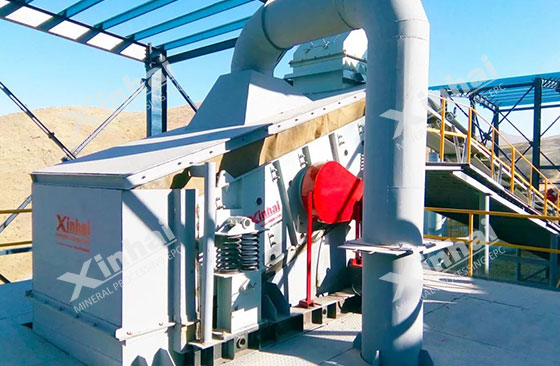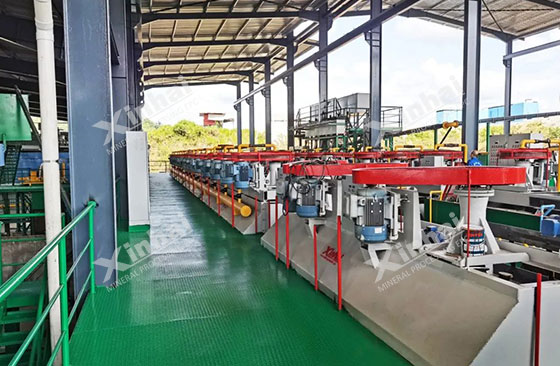Manganese has a variety of valence states and excellent physical and chemical properties, and is widely used in the steel, metallurgy, machinery and other industrial fields. Manganese carbonate ore is one of the important raw materials for manganese recovery. The main minerals include rhodochrosite, calcium rhodochrosite, manganese calcite and rhodochrosite. The gangue minerals are mainly silicate and carbonate minerals, accompanied by a small amount of impurities such as sulfur and iron. Its mineral processing technology covers ore washing, gravity separation, magnetic separation, flotation and leaching, etc., which need to be optimized according to the properties of the ore to improve resource utilization efficiency and economic benefits.
Use the table of contents below to navigate through the guide:
01Manganese carbonate ore washing process
Ore washing is a pretreatment process that uses hydraulic, frictional and mechanical forces to clean the ore surface mud during the ore dressing process. It is usually used before ore crushing or sorting to improve the ore grade and reduce the impact of the mud on subsequent operations. Manganese carbonate ore has a low mud content and a weak degree of cementation between the mud and the ore. It is generally an easy-to-wash ore and can be washed with a vibrating screen. The product under the screen is deslimed and graded with a spiral classifier.

02Manganese carbonate ore gravity separation process
Gravity separation is a technical means to achieve separation based on the density difference of mineral particles through different falling speeds in the medium. The density of manganese carbonate ore is generally 3.6-2.9g/cm³. Due to the small density difference, the single gravity separation method has limited effect on fine-grained manganese carbonate ore. However, for coarse-grained manganese carbonate ore, gravity separation has the advantages of simple process, low cost and low environmental pollution, and is preferred.
In practical applications, carbonate minerals such as calcium rhodochrosite and manganese calcite can be graded by heavy medium hydrocyclone, and then enter the jig for gravity separation after washing. Gravity separation equipment includes heavy medium separator, shaking table, jig, etc. When single gravity separation cannot meet the indicators, it is usually used in combination with magnetic separation or flotation process to further improve the separation efficiency and concentrate quality.

03Manganese carbonate ore magnetic separation process
Manganese carbonate ore is a weakly magnetic mineral. In the beneficiation process, magnetic separation is widely used because of its advantages of small footprint, low energy consumption, low cost, economy and environmental protection. Different magnetic separation methods can be selected for different types of manganese carbonate ores.
For example, for high-iron manganese carbonate ore, wet weak magnetic separation can be used for rough separation, followed by high-gradient strong magnetic separation for sweeping to achieve effective separation and recovery of iron and manganese. For high-sulfur manganese carbonate ore, the main gangue minerals are dolomite, pyrite, etc., and the combined process of strong magnetic separation and flotation can also obtain better beneficiation indicators. When processing low-grade manganese carbonate ore, a high-gradient magnetic separator can be used to enrich it through a roughing and sweeping beneficiation process. Magnetic separation equipment mainly includes dry magnetic separators, wet magnetic separators and high-gradient magnetic separators, which need to be flexibly selected and used according to the specific characteristics of the ore and the beneficiation requirements.
.jpg)
04Manganese carbonate ore flotation process
Manganese carbonate ore has many associated gangues, complex composition and fine embedded particle size. The flotation process can effectively enrich the fine-grained manganese carbonate ore. Usually, the manganese carbonate ore adopts the positive flotation process. In the flotation process, the collectors are mostly carboxylic acid reagents such as oleic acid and sodium oleate, oxidized paraffin soap, sodium petroleum sulfonate, tall oil, cyclohexane acid, and alkyl hydroxamic acid. In the flotation process, in order to promote the hydrophobic effect of the collector on the mineral surface, fuel oil and kerosene are often added as promoters. In addition, by reasonably selecting the combination of reagents and their dosage, the flotation index can be effectively optimized and the mineral processing effect can be improved.

05Manganese carbonate ore leaching process
Leaching is to change the properties of minerals through chemical methods to achieve comprehensive recycling of minerals. The leaching process of manganese carbonate ore mainly includes three methods: pre-roasting leaching, direct acid leaching and microbial leaching.
Pre-roasting leaching: reducing high-valent manganese to low-valent manganese, recovering manganese in the form of ions during the leaching process, suitable for recovering high-valent manganese resources.
Direct acid leaching: directly acting on manganese carbonate ore through sulfuric acid, hydrochloric acid or industrial waste acid, it is necessary to strictly control parameters such as temperature, solid-liquid ratio, acid leaching time and stirring intensity.
Microbial leaching: using acidic substances produced by microbial metabolites to act on ore, it has the advantages of less reagent demand, low cost and less environmental pollution, but the leaching speed is slow and has high requirements for production conditions. It is currently mainly used in laboratory research.

With the increasing refinement of manganese carbonate ore and the difficulty of beneficiation, a single beneficiation method can no longer meet the actual needs, so a combined beneficiation process is often used. Before operation, a comprehensive beneficiation test analysis should be carried out on the ore, and the process configuration should be scientifically optimized according to the properties of the ore to ensure an ideal return on investment and high-quality manganese carbonate ore concentrate.


 marketing@ytxinhai.com
marketing@ytxinhai.com  0086 13810327080
0086 13810327080 






































































































 CHAT
CHAT MESSAGE
MESSAGE

.jpg)



